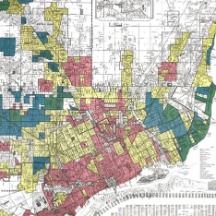Racist policies from the 20th century have left minority communities disproportionately impacted by environmental pollution and global warming, researchers find. Through studies conducted nationwide, researchers have determined that urban neighborhoods historically “redlined” by the federal government suffer from higher levels of air pollution and tend to be several degrees warmer than nearby communities.
Redlined communities were also targeted—and are still—for industrial development unlike the affluent suburbs nearby.
How did this happen? Following the Great Depression, the U.S. economy was faced with nationwide housing shortages. The federal government stepped in and designed color-coded maps to help banks determine “safe” locations to insure mortgages. Minority neighborhoods—typically African-Americans and immigrants—were redlined to indicate high risk, while privileged white communities were favored for housing opportunities. Nine decades later, these communities continue to have lower income and suffer from deteriorating infrastructure, making them more susceptible to environmental hazards.
Redlined communities were also targeted—and are still—for industrial development unlike the affluent suburbs nearby. Overrun with manufacturing facilities, highways and warehouses, they face what is known as the “urban heat island” effect and suffer from warmer temperatures due to heat-trapping structures, pavement and cement. They also lack green infrastructure like trees and cooling canopy cover.
Yesteryear’s Redlining Means Environmental Racism Today
Our Space


The policies of segregation that the U.S. followed “were so powerful that they determine the racial landscape of today,” says Richard Rothstein of the Economic Policy Institute and author of The Color of Law: A Forgotten History of How Our Government Segregated America. “…other neighborhoods are now unaffordable to them, [so they are] restricted to neighborhoods where there are fewer trees, where there is more heat.” Urban communities are often chosen for industrial developments, like pipelines and facilities with high-pollutant discharge, causing poorer living conditions and increased health risks.
Studies find that people living in redlined neighborhoods can have lifespans up to 30 years shorter than others in nearby areas, due to conditions brought on by environmental hazards. Such communities are much more likely to suffer from poor health and lower financial health and have less ability to cope with these effects, says Vivek Shandas, a professor of urban studies and planning at Portland State University studying the link between redlined communities and warmer temperatures.
In a nation grappling with discrimination, environmental justice efforts need to prioritize these marginalized communities. Some Democratic candidates have made climate change impacts on urban, minority and low-income communities a focus of their platforms. Addressing these challenges will require understanding how not everyone has the same capacity to adapt to environmental burdens. In order to ensure a fair and just world for all, we need to acknowledge and address mistakes of the past.
Also read in this issue: Reparations Interim Report Released
Studies find that people living in redlined neighborhoods can have lifespans up to 30 years shorter than others in nearby areas, due to conditions brought on by environmental hazards. Such communities are much more likely to suffer from poor health and lower financial health and have less ability to cope with these effects, says Vivek Shandas, a professor of urban studies and planning at Portland State University studying the link between redlined communities and warmer temperatures.
In a nation grappling with discrimination, environmental justice efforts need to prioritize these marginalized communities. Some Democratic candidates have made climate change impacts on urban, minority and low-income communities a focus of their platforms. Addressing these challenges will require understanding how not everyone has the same capacity to adapt to environmental burdens. In order to ensure a fair and just world for all, we need to acknowledge and address mistakes of the past.
Also read in this issue: Reparations Interim Report Released
Advertisers | Contact Us | Events | Links | Media Kit | Our Company | Payments Pier
Press Room | Print Cover Stories Archives | Electronic Issues and Talk Radio Archives | Writer's Guidelines






